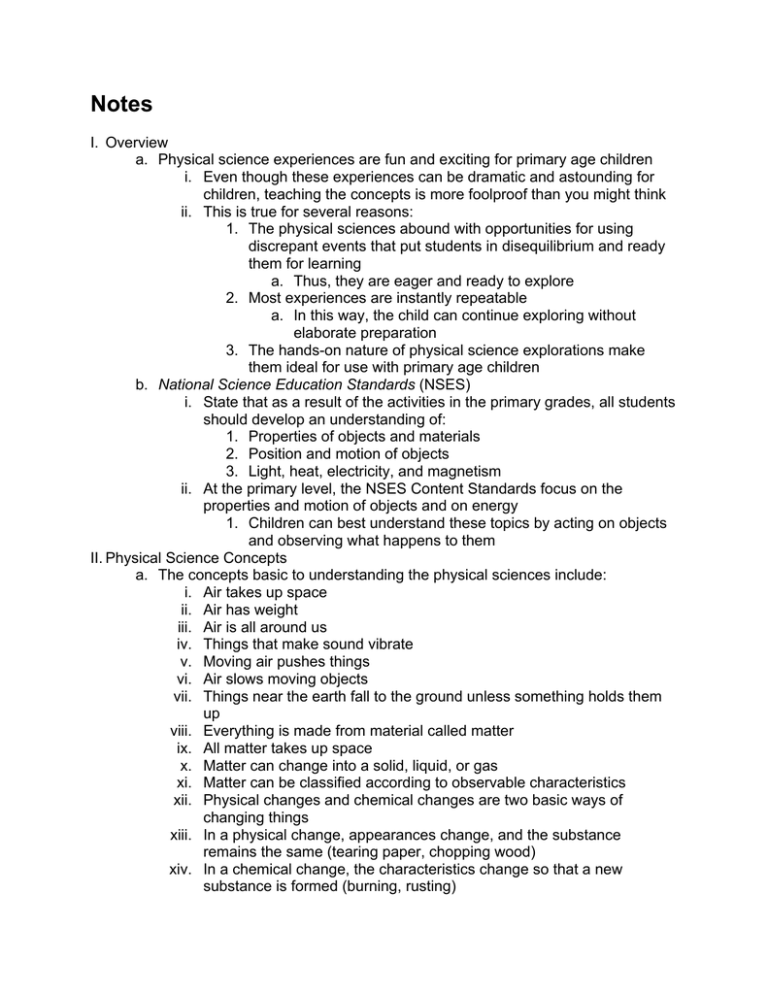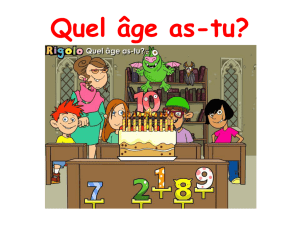I. Overview a. Physical science experiences are fun and exciting for
advertisement

Notes I. Overview a. Physical science experiences are fun and exciting for primary age children i. Even though these experiences can be dramatic and astounding for children, teaching the concepts is more foolproof than you might think ii. This is true for several reasons: 1. The physical sciences abound with opportunities for using discrepant events that put students in disequilibrium and ready them for learning a. Thus, they are eager and ready to explore 2. Most experiences are instantly repeatable a. In this way, the child can continue exploring without elaborate preparation 3. The hands-on nature of physical science explorations make them ideal for use with primary age children b. National Science Education Standards (NSES) i. State that as a result of the activities in the primary grades, all students should develop an understanding of: 1. Properties of objects and materials 2. Position and motion of objects 3. Light, heat, electricity, and magnetism ii. At the primary level, the NSES Content Standards focus on the properties and motion of objects and on energy 1. Children can best understand these topics by acting on objects and observing what happens to them II. Physical Science Concepts a. The concepts basic to understanding the physical sciences include: i. Air takes up space ii. Air has weight iii. Air is all around us iv. Things that make sound vibrate v. Moving air pushes things vi. Air slows moving objects vii. Things near the earth fall to the ground unless something holds them up viii. Everything is made from material called matter ix. All matter takes up space x. Matter can change into a solid, liquid, or gas xi. Matter can be classified according to observable characteristics xii. Physical changes and chemical changes are two basic ways of changing things xiii. In a physical change, appearances change, and the substance remains the same (tearing paper, chopping wood) xiv. In a chemical change, the characteristics change so that a new substance is formed (burning, rusting) III. IV. xv. A mixture consists of two or more substances that retain their separate identities when mixed together xvi. Temperature tells how hot or cold an object is xvii. There are many types of energy—light, heat, sound, electricity, motion, magnetic xviii. Magnets can be used to make some things move without being touched xix. Static electricity is produced when two different materials are rubbed together xx. There are three parts to a simple electric circuit: a source of electricity, a path for electricity to travel, and something that uses the electricity (a light bulb or bell) xxi. Some materials allow electricity to pass through them xxii. To see color, light is needed xxiii. The way to change how something is moving is to give it a push or a pull xxiv. Machines make it easier to move things xxv. Things move in many ways, such as straight, zigzag, around and around, back and forth, and fast and slow Planning and Teaching a Unit About Air a. The topic of air is explored with bubble and sound lessons b. Recommended activities include: i. The Bubble Machine ii. Inventing Bubble Machines iii. Tabletop Bubbles c. Investigation questions for exploring air and bubbles i. Will other liquids create bubbles? ii. Will adding a liquid called glycerin to the bubble solution make the bubbles stronger? (Yes.) 1. Can you think of other things to add to the bubble solution to make the bubbles last longer? 2. Test your formulas iii. Are bubbles always round? 1. (Yes, unless some of them stick together. Forces acting inside and outside of the soap film are the same all over it.) Subject Integrations a. Bubbles and science i. Observe bubbles ii. Classify bubbles iii. Changes in matter b. Bubbles and art i. Bubble painting ii. Bulletin board c. Bubbles and math i. How high? ii. Lung capacity d. Bubbles and language arts i. Bubble books ii. Books about bubbles iii. Chart story e. Bubbles and food experiences i. Children can observe the tiny air bubbles that go into various whipped mixtures 1. Whipped milk topping can be made for cookies f. Concept: air can move things and slow things down i. Suggestions that extend science concepts include: 1. Moving bubbles 2. Paper fans 3. Glider designs 4. Straw painting 5. Make pinwheels 6. Air walk 7. Exploring parachutes 8. Baby seeds 9. Air movers g. Exploring sound i. Children love to make music, but they probably do not know anything about the nature of sound 1. Help them understand that sound is caused when something vibrates by using the following lessons to teach children to see, hear, and feel the sound vibrations around them 2. Then, make musical instruments that reinforce the concepts h. Wind instruments i. Wind instruments such as flutes, whistles, and panpipes depend on vibrating columns of air for their sound 1. The longer the column of air, the lower the pitch a. The highness or lowness of a sound is its pitch b. The more vibrations per second, the higher the tone that is produced; the fewer vibrations, the lower the tone i. Properties of matter i. National Science Education Standards suggest that young children need to understand that matter can be classified according to observable characteristics 1. Children’s experience observing, manipulating, and classifying common objects provides the foundation for much of their later learning ii. Children build concepts related to the properties of objects and materials by engaging in a variety of experiences requiring them to: 1. Observe and describe the properties of objects 2. Compare objects for their observable similarities and differences 3. Sort or group objects based on their similarities iii. Activities that provide early experiences with ordering and classifying according to observable characteristics using the senses include: 1. Shape and Size 2. Smell 3. Temperature 4. Weight V. Exploring Light a. Children need many concrete experiences with light to provide the conceptual background necessary for later understanding i. Help children understand the NSES for light 1. Light travels in a straight line until it strikes an object 2. Light can be reflected by a mirror, refracted by a lens, or absorbed by objects b. Recommended learning experiences include: i. Light Beam Tag ii. Instructional Technology: The Light Sensor c. Assessment strategies i. Because many primary children are beginning readers, simple performance assessments designed around process skills and anecdotal records can be used to determine understanding 1. When recording children’s oral explanations of what is happening, it is better to place the emphasis on the child’s ability to communicate ideas, rather than the use of terminology 2. When children are completing a task, write down snippets of informal conversation relating to the task ii. Another assessment strategy might include having the children sort objects into categories, setting out an object that does not fit in either category 1. Observe how the children either incorporate the object or change the categories, and relate these observations to progress © 2010 Wadsworth, Cengage Learning.


